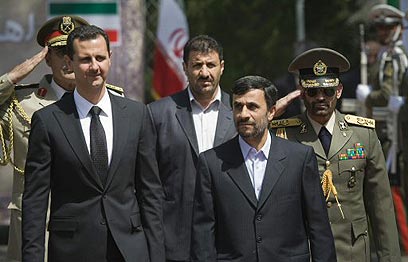
Nuclear experts in the US and Middle East have raised concerns about the security of up to 50 metric tons of unenriched uranium in Syria, the Financial Times reported Tuesday.
Such a stockpile could be a vital resource to building a nuclear bomb and could have disastrous implications if seized by Iran.
Related stories:
- Report: Israel stopped Assad's chemical warfare
- 'IAF dropped 17 tons of explosives on Syria reactor'
- Iran backs Assad peace initiative for Syria
Not much is known about the Syrian nuclear program, and the country denied ever having had one. But intelligence data collected at the time indicated that President Bashar Assad regime’s was close to completing a nuclear reactor at Al-Kibar, in the east of the country, when it was reportedly destroyed by Israeli jets in September 2007.
Intelligence officials have long believed that the reactor was familiar in its design to the Yongbyon facility in North Korea, which aided Syria with its program. By comparing the two reactors, experts have concluded that Al-Kibar would have required about 50 tonnes of natural uranium fuel to become operational.

Syria's Assad with Iran's Ahmadinejad. (Photo: Reuters)
Government officials and nuclear experts have recently told the Financial Times that there were legitimate concerns about a uranium stockpile of such magnitude which may have remained in Syria. According to experts, such a stockpile would be enough to provide weapons grade fuel for five atomic devices.
“There are real worries about what has happened to the uranium that Syria was planning to put into the Al-Kibar reactor shortly before the reactor was destroyed in 2007,” David Albright, the head of the US-based Institute for Science and International Security think-tank told the Financial Times.
“There’s no question that, as Syria gets engulfed in civil war, the whereabouts of this uranium is worrying governments. There is evidence to suggest this issue has been raised by one government directly with the IAEA.”
Iran trying to seize uranium?
An IAEA inspection team visited the destroyed Al-Kibar site in May 2008 and only found traces of uranium, adding to the mystery of where the stockpile might be.
According to the report, some government officials have expressed fears that Iran, which is closely allied to Syria and needs uranium for its nuclear program, might be trying to seize the uranium.
These concerns have been brought upon by signs of movement at what they allege is a secret uranium conversion facility that the Syrian regime built at the town of Marj al-Sultan near Damascus.
“You could draw the conclusion that there may be something at this site that the Syrian authorities are keen to defend from opposition forces,” said Albright, an expert on the Iranian nuclear program. “It would be interesting to know what it is.”
While the officials were unable to unequivocally determine whether uranium was in fact stored at the site, they said that Syria is almost certainly in possession of the element urgently sought by Iran.
"It would certainly be possible to transfer this from Syria to Iran by air,” one official said.
If Iran were to attempt to build another secret uranium plant, such a stockpile could be instrumental and could be used to build a bomb.
- Receive Ynetnews updates
directly to your desktop















